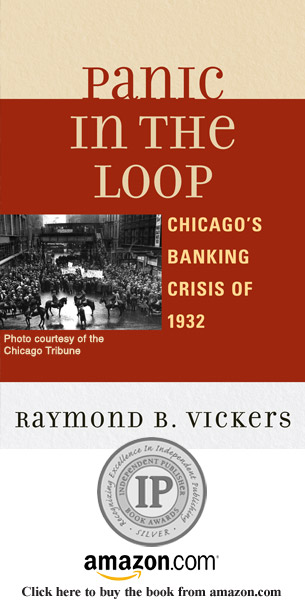 “Rarely has the case for transparency in the regulation of banks been made so well. It is hard to imagine that the bankers that caused the Chicago panic of 1932 would have been so brazen or the regulators so slow to stop them if their actions had been quickly made public.”
“Rarely has the case for transparency in the regulation of banks been made so well. It is hard to imagine that the bankers that caused the Chicago panic of 1932 would have been so brazen or the regulators so slow to stop them if their actions had been quickly made public.”
—Eugene N. White, Rutgers University
Relying on a broad array of records used together for the first time, Panic in the Loop reveals widespread fraud and insider abuse by bankers – and the complicity of corrupt politicians – that caused the Chicago banking debacle of 1932. It provides a fresh interpretation of the role played by bankers who turned the nation’s financial crisis of the early 1930s into the decade-long Great Depression. It also calls for the abolition of secrecy that still permeates the bank regulatory system, which would have prevented the Enron fiasco and the financial meltdown of 2008.
During Chicago’s panic in June 1932, bank failures reached epidemic proportions when forty-two banks collapsed . Panic in the Loop proves that each and every bank that failed did so because of massive insider abuse and fraud. Bank officers and directors engaged in illegal and unsound practices that encumbered every one of the banks with reckless loans and unsafe securities investments, which no prudent management would have made. Playing central roles in the banking debacle were Charles Dawes, the former vice-president of the United States, and utility tycoon Samuel Insull, as well as Jesse Jones and other officials of the Reconstruction Finance Corporation who bailed out the Dawes bank.
This book focuses on the recurrent failures of the financial system — the savings and loan crisis of the 1980s, the Enron debacle of the early 2000s, and finally the financial collapse of 2008. Because of regulatory secrecy, knowing what happened in Chicago in 1932 is critical to understanding the glaring problems in the regulation of American finance, in particular the lack of transparency, the abuse of financial institutions by insiders, and the capture of public institutions by those going through the revolving door between the private and public sectors.
Eight decades later little has changed. The regulatory failures of the 1930s, especially the pervasive system of secrecy that allowed the fraud and insider abuse to flourish – were repeated during the collapse of 2008. Transparency would strike at the alliance between the executives of financial institutions and public officials, who caused the worst economic upheaval since the Great Depression
Reviews:
“Panic in the Loop is timely in view of the current financial crisis. Vickers uncovers the corruption, betrayal, and theft of public and private funds in 1932 Chicago and establishes a model for uncovering contemporary financial chicanery. Discussion of the Enron crisis gives the analysis contemporary value and validity and raises the specter of corruption behind the sub-prime mortgage facade, corruption authorities (the regulated and the regulators) will use every device at their disposal to hide from the public. Scholars and students will find Panic in the Loop a worthy title for reading lists.”
—David O. Whitten, Auburn University, and author, with Douglas Steeples, of Democracy in Desperation: The Depression of 1893
“Vickers’ has produced a book that stands out in the scholarship of the banking crisis of the 1930s. It’s also greatly relevant to the recent financial collapse that has rocked the American and world economies. In the more than 75 years since the 1932 Chicago banking crisis little has changed. Insider abuse at banks, weak regulation, and the protection of miscreants by powerful politicians of both major parties characterize what happened in the 1930s and recently. Deeply probing research in records often over looked by scholars allows Vickers to carefully expose the web of private and public influence and often fraudulent behavior that sank Chicago’s leading banks in the 1930s. His research should inspire scholars and investigators determined to discover the roots of our recent financial collapse.”
—William H. Becker, The George Washington University
About the Author
Raymond (Vic) Vickers, whose background includes a Ph.D. in economic and business history, has practiced law for more than three decades and has represented more than a hundred financial institutions. He also served as the Assistant Comptroller of Florida, which made him the Chief of Staff of the Florida Department of Banking and Finance and the top appointed banking and securities regulator for the state of Florida. He is also the author of Panic in Paradise: Florida’s Banking Crash of 1926.



